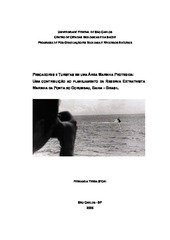| dc.contributor.author | Stori, Fernanda Terra | |
| dc.date.accessioned | 2016-06-02T19:32:16Z | |
| dc.date.available | 2007-07-10 | |
| dc.date.available | 2016-06-02T19:32:16Z | |
| dc.date.issued | 2005-06-10 | |
| dc.identifier.citation | STORI, Fernanda Terra. Pescadores e turistas em uma área marinha protegida: uma contribuição ao planejamento da Reserva Extrativista Marinha da Ponta do Corumbau, Bahia - Brasil.. 2005. 190 f. Dissertação (Mestrado em Ciências Biológicas) - Universidade Federal de São Carlos, São Carlos, 2005. | por |
| dc.identifier.uri | https://repositorio.ufscar.br/handle/ufscar/2138 | |
| dc.description.abstract | Marine-coastal areas in the South of Bahia State in Brazil has experimented environmental and social changes, related to the over-exploitation of the fishery stocks and to the overflow of carrying capacity of the bathing resorts. Most of traditional communities are migrating out forced by the oppressive tourism economy, leaving fishery and facing cultural and social conflicts. A Marine Protected Area called Ponta do Corumbau Marine Extractive Reserve (or Corumbau Resex) was created in the year 2000, with the aim of sustainability of artisanal fisheries against predatory industrial activity, and to protect a rich biodiversity. The present research has as main objective to contribute to the planning of tourism in this Marine Protected Area through identification of potentialities and conflicts, social and ecological, of tourism activity in the tree studied villages: Cumuruxatiba, Corumbau e Caraíva. There were applied 157 semi-structured questionnaires between tourists and extractivists (fishermen) allowing to investigate the perception of the region and its context in two points of view. The scenic beauty, an opportunity of resting and freedom as well as local receptivity were appointed as the main potentialities by the interviewed tourists. Speculation for land property was identified as motive of conflicts on social relations and extractive culture. Other problems, mostly related to the infrastructure from the villages were also identified. Most of the interviewed extrativists (45% in Cumuruxatiba, 55% in Corumbau and 85% in Caraíva) are nowadays involved with tourism activities. It was possible to note that an initial period of visitation was occurred in the end of seventies and the tourist activity on the tree villages was identified in transition between the Involvement stage to
Development, according to Butler (1980). In the same way, according to Smith (1991), Corumbau was identified as Resort Established and Cumuruxatiba and Caraíva as Business Area Established. Such results shows the necessity to control the tourism growing and to an adequate planning of this activity, aiming to link conservation of natural resources, social and economic benefits to extractive communities and the
valorization of the artisanal fishery system, the main reason of the Corumbau Resex creation. | eng |
| dc.description.sponsorship | Universidade Federal de Sao Carlos | |
| dc.format | application/pdf | por |
| dc.language | por | por |
| dc.publisher | Universidade Federal de São Carlos | por |
| dc.rights | Acesso Aberto | por |
| dc.subject | Ecologia humana | por |
| dc.subject | Unidades de conservação | por |
| dc.subject | Turismo | por |
| dc.subject | Pesca artesanal | por |
| dc.subject | Gerenciamento costeiro | por |
| dc.title | Pescadores e turistas em uma área marinha protegida: uma contribuição ao planejamento da Reserva Extrativista Marinha da Ponta do Corumbau, Bahia - Brasil | por |
| dc.type | Dissertação | por |
| dc.contributor.advisor1 | Nordi, Nivaldo | |
| dc.contributor.advisor1Lattes | http://genos.cnpq.br:12010/dwlattes/owa/prc_imp_cv_int?f_cod=K4792470U2 | por |
| dc.description.resumo | As áreas costeiras ao Sul do Estado da Bahia, Brasil, têm passado por diversas transformações sociais e ambientais relacionadas à sobreexplotação dos estoques pesqueiros e à extrapolação da capacidade de suporte de balneários turísticos. A maior parte das comunidades tradicionais está migrando forçada pela economia opressiva do turismo, deixando a pesca e enfrentando conflitos sócio-culturais. No ano 2000 a Reserva Extrativista Marinha da Ponta do Corumbau (Resex do Corumbau) foi criada com o objetivo de garantir a sustentabilidade da pesca artesanal frente à atividade industrial predatória e proteger a rica biodiversidade local. A presente pesquisa tem como objetivo principal, contribuir para o planejamento do turismo nesta Unidade de
Conservação, através da identificação de potencialidades e conflitos, sociais e ecológicos, da atividade turística em três vilas estudadas: Cumuruxatiba, Corumbau e Caraíva. Ao todo, foram aplicados 157 questionários semi-estruturados entre turistas e extrativistas, o que possibilitou investigar a percepção sobre a região e seu contexto em dois pontos de vista. A beleza cênica, a oportunidade de descanso e liberdade, bem como a receptividade do povo local, foram as principais potencialidades apontadas pelos turistas entrevistados. A especulação imobiliária foi identificada como causadora de conflitos nas relações sociais e na cultura extrativista. Problemas em grande parte relacionados à infra-estrutura das vilas, também foram identificados. Dos extrativistas entrevistados, grande parte (45% em Cumuruxatiba, 55% em Corumbau e 85% em Caraíva) envolve-se atualmente com turismo. Foi possível notar que a fase inicial de visitação se deu ao final da década de 70 e a atividade turística nas três vilas foi identificada atualmente em transição da fase de Envolvimento para a de Desenvolvimento, segundo Butler (1980). Da mesma forma, segundo Smith (1991), Corumbau foi identificada como Balneário Estabelecido e Cumuruxatiba e Caraíva como Área Comercial Estabelecida. Tais resultados apontam para a necessidade de medidas de controle do crescimento do turismo e o planejamento adequado desta atividade, procurando aliar a conservação dos recursos naturais com benefícios socioeconômicos às comunidades extrativistas e a valorização do sistema pesqueiro artesanal, principal motivo da criação da Resex do Corumbau. | por |
| dc.publisher.country | BR | por |
| dc.publisher.initials | UFSCar | por |
| dc.publisher.program | Programa de Pós-Graduação em Ecologia e Recursos Naturais - PPGERN | por |
| dc.subject.cnpq | CIENCIAS BIOLOGICAS::ECOLOGIA | por |
